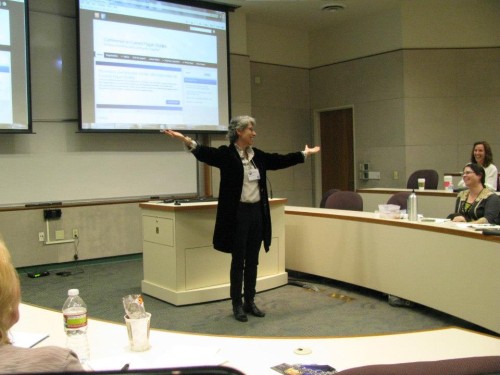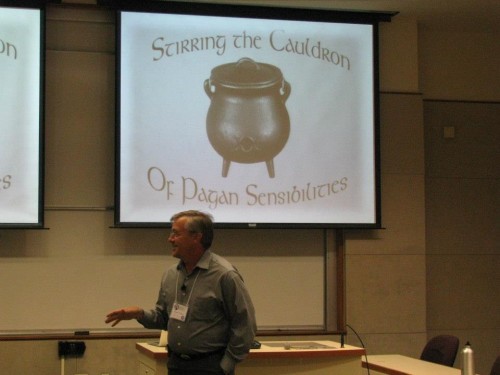Well, needless to say I thoroughly enjoyed the Conference again this year, the presentations, and especially those by the two keynote speakers, were excellent, and I left invigorated. Thanks so much for those who so generously make this Conference possible, especially Kahena, Jeffrey, and William!
I take the libery of copying here a review by Patrick Wolff from The Wild Hunt.
[The following is a guest post from Patrick Wolff on The Wild Hunt, a well known Neo-Pagan Blog. Wolff is a professor of religious studies and holds a PhD in the history of religious thought.)
Pagans Studied: The 2013 Conference on Current Pagan Studies
The ninth annual Conference on Current Pagan Studies met at Claremont Graduate University in the city of Claremont, California on January 26-27. This is a unique academic conference, not only for its topical focus on Pagan Studies, but for its inclusion of both academic and non-academic Pagans as presenters. Both the conference theme and the selection of keynote speakers exemplified the desire to, as the tagline of the conference website puts it, bring “Academia and Community Together.” The conference theme, “Pagan Sensibilities in Action,” covered not only ritual and spiritual practice but history, art, social justice, environmental concerns, psychology, politics, and other topics. The theme reflected a concern that is current in many religions, a desire to explore the implications of one’s theology (or thealogy, or theoilogy, as the case may be) in all aspects of life.The two keynote speakers embodied this theme, one a recognized scholar in the fields of folklore and anthropology and the other an activist with experience fighting for social justice as well as service through disaster relief and emergency care. Dr. Sabina Magliocco, Professor of Anthropology at California State University, Northridge, and author of numerous books including Witching Culture: Folklore and Neo-Paganism in America and Neo-Pagan Sacred Art and Altars: Making Things Whole, presented a lecture titled “The Rise of Pagan Fundamentalism.” Joking that she hoped to avoid being tarred and feathered, Magliocco identified two tendencies of Pagan Fundamentalism, both of which centered on the concept of belief. As a broad religious phenomenon, fundamentalists in all religions insist on a literalist interpretation of foundational texts, and demand conformity of belief as the primary marker of a genuine religious identity. Those who do not share these essential beliefs are viewed with suspicion, or rejected as imposters.
The first belief is in the literal historicity of the foundational narrative of paganism as an unbroken stream flowing from the ancient past to the present. This “received” view of Pagan (particularly Wiccan) history, shaped by Margaret Murray and Gerald Gardner, holds that the Old Religion persisted throughout the centuries amidst persecution, passed down as a closely guarded secret to initiates into the present day. However, when subjected to the scrutiny of critical historical scholarship, the foundational myth of pure Paganism transmitted through the ages was revealed to be lacking in solid historical evidence.
Revisionists, most notably English historian Ronald Hutton, author of Triumph of the Moon: A History of Modern Pagan Witchcraft, contended that Wicca was better understood as a new religious movement than as a preserved ancient one. Counter-revisionists, such as Ben Whitmore, author of Trials of the Moon: Reopening the Case for Historical Witchcraft, have objected that Hutton overstated his case, ignoring or minimizing evidence for continuity in the transmission of Wicca (to which Hutton has replied in his article “Revisionism and Counter-Revisionism in Pagan History” in the most recent issue of Pomegranate). The claims of revisionist historians can come as quite a shock to Pagans who never had reason to question the received myth of Pagan origins, and while many were open to the new perspective, others experienced a crisis of cognitive dissonance which was countered by an uncritical insistence on the literal truth of the myth of pagan origins and a dismissal of, or attack on, revisionist arguments. Since the revisionist perspective presented Wicca as an eclectic, creative religious movement influenced by other forms of occultism and Romanticism, those most opposed to it were often those whose Paganism was heavily invested in the claim of possessing secret knowledge passed through carefully guarded secret initiations. This debate over Pagan origins is not merely an ivory tower discussion, since how Pagans view their past will shape their future.
The second tendency that has emerged in Pagan Fundamentalism is a belief in gods and goddesses as literal spiritual persons, formulated as a reaction against the emergence of humanistic paganism and panentheistic or archetypal interpretations of the divine. However, Magliocco argued, historically Wiccans have varied greatly in their theology, and found unity not in right belief, but in common practice. Against this non-dogmatic tradition of finding shared identity through ritual, Pagan Fundamentalists seek to exclude those who do not hold to their “orthodox” pagan belief in the nature of the gods. This is problematic, Magliocco argued, because it imported a criteria from the dominant Abrahamic faiths that was ill-suited to the ritual-focused nature of Paganism.
Why has belief emerged as a critical identity marker now, when it did not function this way in the past? Magliocco pointed to several reasons, such as a desire legitimate Paganism as a “real religion” in the eyes of adherents of other religions (which comes as a result of the growth in size and influence of Paganism), and a quest for certainty in a tumultuous marketplace of religious ideas (a motivating factor in the fundamentalist strand of all religions). But her third reason pointed to what would become a theme throughout much of the rest of the conference: the role of the Internet, and particularly comments on blogs, that dank and murky lair of trolls, where insults fly freely and rational reflection is beaten down by bombast. The Internet tends to encourage “enclaves of idiosyncratic views,” unchallenged by real-world interaction with those holding differing views, and provides a veil of anonymity that allows abusive behavior that would not be tolerated in face to face interactions. After her presentation, one questioner raised the intriguing possibility that the Internet actually encourages fundamentalism, since online (particularly in blogs and blog comments) individuals are easily reduced to text-based persons.
The second keynote address, “Stirring the Cauldron of Pagan Sensibilities,” was presented by Peter Dybing, a national disaster team Section Chief with experience as a firefighter and EMT as well as serving on the board member 100% for Haiti and a former National First Officer of Covenant of the Goddess. Stressing is non-academic identity, Dybing challenged attendees to “suspend your academic approach, and access your emotions,” issuing a call to action rather than offering intellectual reflection. His first two points called for a new look at the questions of Pagan leadership and the role of elders. While acknowledging the strengths found in Traditional (hierarchical, individual-focused) and Organic (communal and local) models of leadership, as well as the dangers of what he termed Fantasy Leadership (the self-appointed blogger harassing his or her enemies online, “liked” by clique of online admirers ), Dybing drew from his experience in disaster relief to formulate a Transformative model of leadership, one that is mission-based and organizationally-focused. Leadership should not be limited to the Priest or Priestess as representatives of the God or Goddess, but should be shared based on recognition of diverse skills and expertise. On the related topic of Pagan elders, Dybing stressed the importance of honoring the body of work left by an elder without venerating the person. Elders, even after death, must be remembered as human beings, not saints.
Though the first part of presentation took up the majority of his time, it was in the second part that Dybing most fully revealed his own heart through a call to service as an expression of Pagan spirituality. It was in offering direct aid for the good of others, whether in international aid or in community service, that Dybing said he most fully felt the presence of the Goddess. In a time of environmental degradation, Dybing warned, we must expect a future of natural disasters on an unprecedented scale, and Pagans are uniquely qualified to respond to these challenges. While Magliocco made the case that Paganism should continue to value ritual action over belief, Dybing called on Pagans to pursue active service as a practice of Pagan spirituality.
The other twenty-five presentations were too varied and rich to be adequately summarized here, with topics ranging from theology to psychology, good pedagogy in the classroom to creating masks (and even the pedagogy of making masks), environmentalism, politics, and mysticism. One particularly exciting project described was the Pagan History Project, which will record oral histories of Pagans, similar to the oral history project being conducted by many universities of World War II veterans. Several times a desire was expressed to continue discussion after the conference ended, either on the conference website or Facebook page. This does not seem to have happened yet, but it would be another way to bring Pagan scholarship into conversation with the broader Pagan community. In addition to the thoughtful nature of the presentations, two other aspects of the conference are worth noting. First, there was an ethos of dialogue and conversation among the approximately fifty attendees, so much so that interaction between the presenter and audience sometimes broke out in the middle of a presentation, a rare occurrence in a typical academic conference. Second, the atmosphere of the conference could be described as convivial, with a great deal of laughter and good spirits. In this way, the conference itself was a manifestation of Pagan sensibility.
Pagan Studies has come under recent criticism by some for a lack of necessary critical distance from its subject (see, for example,, Markus Altena Davidsen, “What is Wrong with Pagan Studies?” in Method and Theory in the Study of Religion, available online). This criticism is not without merit. The calling of a scholar of religion is not to support the religion being studied, but to understand it, and the conclusions that come from scholarly inquiry are not always welcome to those being studied (hence Magliocco’s “tar and feathering” comment). Further, too much of an “insider” atmosphere can create an us-and-them dichotomy which distances or even excludes outsiders. The “them” could be non-insider scholars or practitioners of other religions, viewed as outsiders who can never really “get” those on the inside (some of this could be seen by the dramatic eye-rolling and snarky asides from one presenter whenever he made mention of Christian beliefs, something that would not be tolerated in other academic conferences). One Pagan Reconstructionist presenter admitted she had felt nervous about attending a conference of Wiccans and Neopagans, and while she was warmly welcomed, her initial misgivings say something about how the conference could be perceived by outsiders.
The lines of insider and outsider in scholarship are not always clear cut, however, and if there is a danger in insider scholarship designed to offer the benefits of scholarly insight to contribute to the flourishing of one’s own religious community, the opposite danger is scholarship for the sake of no one, except perhaps the expansion of the scholar’s own reputation (and ego). Granted that much of what academics call risky seems rather dreary to most people, the conference organizer, Dorothea Kahena Viale, should be commended for taking the risk of envisioning a conference that seeks to connect scholars with practitioners and intellectuals with activists. There must be a place for scholarship for the good of the community, and for Pagans, one place this can be found is the Conference on Current Pagan Studies.



2 comments:
Great post. It sounds like it was a good conference. I find it interesting that there is divisiveness in a community like this about whether gods and goddesses are real.
Well, I think what they mean is comparable to what goes on in Christianity, or any religion........ "Fundamentalism" vs. metaphor and spirituality. To me fundamentalism is a closed system, and a closed mind, by whatever name or practice........
Post a Comment